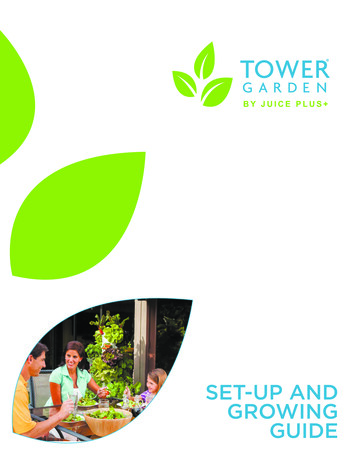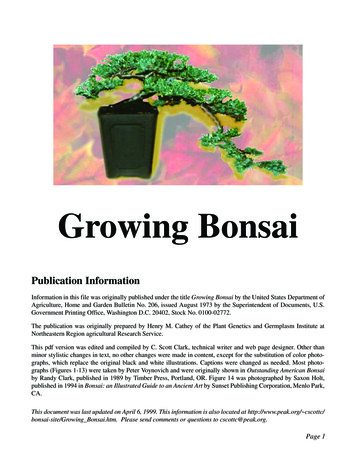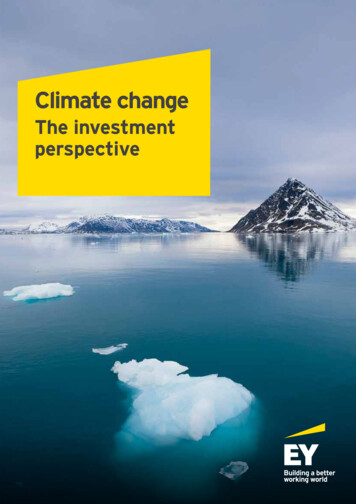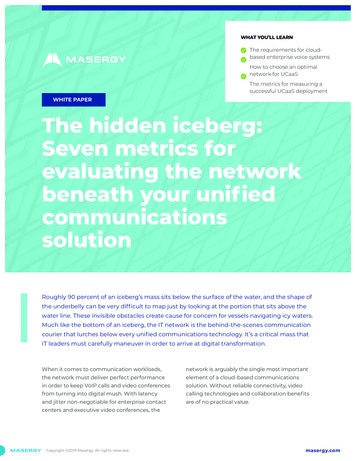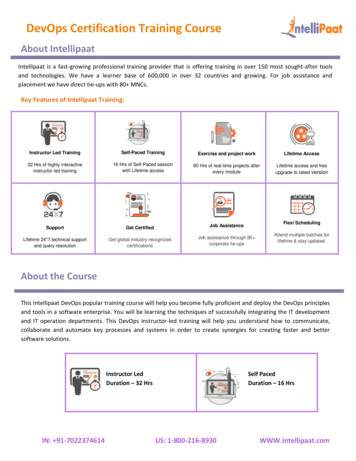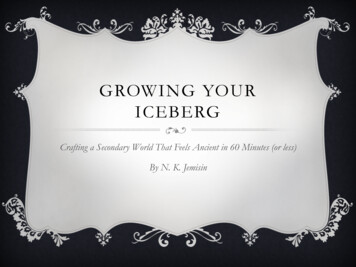
Transcription
GROWING YOURICEBERGCrafting a Secondary World That Feels Ancient in 60 Minutes (or less)By N. K. Jemisin
SKIFFY STUFF AHEADv This workshop assumes a certain basic familiarity with “speculative”fiction: science fiction, fantasy, horror, literary fiction that delves into thenuminous or the weird, alternate histories. I will abbreviate thiscollectively as “SFF”, for “science fiction, fantasy, and other”.v If you aren’t familiar with SFF, there are several recommended startertitles herein. Check out the Nebula and World Fantasy Awards lists, too.
FORMAT1. Introduction to secondary worldbuilding: hazards, concerns,things to consider2. What’s awesome about secondary worldbuilding3. Let’s build a world!4. Q&A.
ICEBERG RIGHT AHEADv A common adage of speculative fiction writing is thatworldbuilding should be like an iceberg: only 10% should bevisible above the surface, with the rest hidden underneath.v Two problems with this adage:1. It implies that there’s something scary or dangerous about thathidden 90%.2. As with all writing “rules”, it can be broken with care, skill, andunder certain circumstances. E.g. The Silmarillion.
DON’T FEAR THE ICEBERGv Fear of worldbuilding is why we see so many similar worlds doneto death: Iron Age barbarians, Star Trek-ian space navies, medievalnorthern Europe ad infinitum. Easier to copy than create.v Worldbuilding is what makes SFF unique; embrace it.v Worldbuilding is like any other writing skill. Practice!
DON’T FEAR THE ICEBERGWill crafting a really “different” world hurt my sales?v Maybe. Then again, so would writing a cliched, overdone setting thatbores readers to death.v Books thrive or fail on their writing: plot, characterization, narrative style,etc. Worldbuilding is just part of that.
#SECONDARYWORLDPROBLEMSv “Secondary world” definition: not the real world. The real world is the“primary” world.v Can be a little different through extremely different, but learningcurve increases with difference.v Learning curves are OK! SFF readers like them! But v Too steep and the reader disengages!v My recommendation: increase immersion as difference increases.
THE IMMERSION PYRAMIDHigh ImmersionThe Hunger Games (Suzanne Collins)If on a winter’s night a traveler (ItaloCalvino)“Tight” Third PersonLimited PoVFirst PersonSecond PersonSingle PoVModerate ImmersionThe Night Angel Trilogy (Brent Weeks)The Coldfire Trilogy (C. S. Friedman)Low ImmersionGormenghast (Mervyn Peake)Lord of the Rings (J. R. R. Tolkein)“Distant” Third PersonMultiple PoVsOmniscient Narrator
IMMERSING IN YOURWORLDv High Immersion: Explain little. The strangeness of the world isconveyed mostly through context, and rarely in the narrative.Glossaries and epigraphs can help.v Moderate Immersion: Explain periodically. Sometimes interruptsthe narrative for explanations of what’s going on.v Low Immersion: Explain frequently. The narrator may directlyaddress the reader. Prologues are common. Danger: infodumping!
WHAT’S AWESOMEv You get to explore anything you find cool, as much as you want,and no one can stop you MWAAAAHAHAHAHA – ahem.v REEEEESEARCHv Glossaries! Maps! Build your own Silmarillion!Let your geek flag fly, my fellow writers.
RESEARCH IS YOUR FRIENDv Books and experts are necessary. Offer coffee or dinner in exchangefor the chance to pick a person’s brains.v Travel may also be necessary. And fun!v No one expects expertise – but they do expect you to have put forth atleast a basic effort.v Useful resources exist to help you generate maps, languages, and more.v Beware research addiction! Set a time limit for the research phase.
ME AT CANYON DECHELLY, 2005 Paid for by a grant from theSpeculative Literature Foundation Most recent trip to Hawaii tostudy volcanoes, 2013 Add a research component to afamily vacation and it can be awrite-off! Talk to youraccountant.
SCIENCE VS PLAUSIBILITYv You can’t research everything.v This is still a speculative world – not Earth, not real, maybe notpossible by the laws of physics (e.g. if magic exists)v This is still fiction – it must engage, not just educate, not just entertainv Use enough science to make sense to the layperson, and no morev Use your writing to sell the “whoppers”v Don’t forget the social sciences!
Now LET’S BUILD A WORLD
PICK YOUR PLANETv Habitable (to the people you’ll create) or inimical?v Continents, archipelago, all ocean, no water at all?v Climate: consider global weather patterns.v Flora and fauna adapted to the abovev Your story’s people will have adapted to the above, too!
Not every planet is Earth, but this isthe planet we know best. Forplausibility’s sake, remember that it isthe planet your audience knows best,too.From PBS.org
LET’S BUILD A WORLDFor the sake of today’s exercise we will assume Habitable Earthlike: more water than land, one sun, one moon, nitrogenoxygen atmosphere Similar ecosystem Human inhabitants at least
TWO CONTINENTSThink “puzzlepieces”. If youhave more thanone continent,they should fittogether.
TWO CONTINENTSmountains
TWO CONTINENTSArctic coldEquatorial heat
TWO CONTINENTSArctic coldEquatorial heat
TWO CONTINENTSCold, arid,mostly desertor tundraWarmer,temperateTropical coastHELL CORRIDORViolent storms, tsunamis,whirlpools, vicious windsMostlytropical
TWO CONTINENTSWe can call it “TheSea of Tears”
TWO CONTINENTSBecause it’s cool
LET’S BUILD A PEOPLEv Our world gives us the basics: Agriculture difficult. Tsunamis,earthquakes, storms frequent. Life dependent on trade and the sea.v Sociology gives us the rest. Many, many characteristics to explore.Overwhelming!Wordle.net
LET’S BUILD A PEOPLEv Even one sociological difference can have profound effects.v Important to understand how societies grow and change.v DO NOT rely on stereotypes or myths.v Sociological recs: Guns, Germs, and Steel (Jared Diamond) The Tipping Point (Malcolm Gladwell) 1491: New Revelations of the Americas Before Columbus(Charles C. Mann)
LET’S BUILD A PEOPLEv Pick three sociological characteristics to start. The rest, inconjunction with the world’s physical characteristics, will dictate therest.v Don’t forget the speculative element! MagicWeird science (e.g. Two moons, “element X”)Another sentient speciesNo more! The world is weird enough already!
LET’S BUILD A PEOPLEv Random selection of characteristics: Art & architecture Sex & sexuality “Element X”
LET’S BUILD A PEOPLEv Art & architecture They build for tsunamis, storms, and earthquakes: elevated on stiltsor pylons, “hanging frame”, wind corridors a la “shotgun homes”,avoid stone, prefer lighter materials Lots of wind and ocean motifs Veneration of resilence, appreciation of ephemeralityv If they have a religion, these elements would influence it. Regardless ofreligion, these will be cultural values.
LET’S BUILD A PEOPLEv Sex & sexuality Sex / gender. Sex physical configurations; gender how societyinterprets those and behavior Resilience: Women have higher pain threshold. Fewer boys survivechildbirth & childhood diseases. Ephemerality: Change with need isvalued. Influenced by ocean life. Tropical fish change sexes as needed.v Three genders recognized: male, female, inter.v Matrilineal. Women head families and captain ships, but men & intersexpected to “become” women as needed.
“ELEMENT X”v Some elements that are very rare in the primary world could beabundant in a secondary world, or vice versa. E.g. gold & platinumeverywhere but not much iron.v Magical/pseudoscience elements: mithril, adamant, “elementzero”, orichalcum, quantium.v Don’t make something that will solve all problems! New elementsshould create new problems.
FURYWOODv Made from trees which grow only along the coast of the Sea of Tears.v Super strong, super light, actually gets tougher after being struck bylightning or set on fire.v Special harvesting methods, more like quarrying or smithingv Ships made of furywood are “fired” before commissioning. Thosewhich have been tested by storms are most valuable.v Powerful navies so long as the secrets of furywood are kept local.
LET’S MAKE A PEOPLEv Seafaring, woman-dominated, three-gendered, traders and raiders who are fearedthe world over for their blackened invincible ships!v Society focused on trading for needed goods, and protecting furywood.v Negative attitude toward medicine: “Get better on your own. Survive if you can.”v Same people on both sides of the Sea of Tears? But after a few generations, theywould differentiate. Possible conflict.v Possible conflict with more agrarian societies, less naval societies, societieshorrified by social structure.
LET’S BUILD A PEOPLEv The rest follows on from there! Well-developed climate science and astronomy (also mathematics)Possible animist religion centered on the seaDefensive technology around protecting furywood stands.Society structured around trading families; anti-individualistic.Without agriculture (arable land) and patrilineage, little need forpermanent marriage. The rarity of inters would make them desirableand possibly venerable. Resilient men sought after for child-making; violent, risk-taking menwho seem prone to die young less so.
YO U ’ V E H A D A G R E AT S T A R T ! N OWWORK HARDER.v That was just the world. You still need to select characters and build a plot!v Low immersion example: The sprawling epic tale of three families’ struggle fortrading dominance, told from six PoVs, with maps and glossaries and explanations. Title:The War of Tearsv High immersion example: The romantic first-person saga of an orphaned boy whoyearns to captain a furywood ship. As he grows up he must earn the favor of a tradingfamily’s matriarch, romance a high-status inter, and (once he’s got it) fend off foreignerswho want his beloved ship. Title: Tearbreaker (the name of the ship)
THIS IS YOUR WORLDv You are welcome to build a story in the world created by thisworkshop. Remember, ideas cannot be copyrighted. The uniquenessof a story lies in its execution.v If you want to credit me, go ahead, but you don’t have to!v I’m not planning to write anything in this world. I’ve got plenty ofmy own worlds to play in already.v Try running the exercise again, but making different choices!
QUESTIONS
fiction: science fiction, fantasy, horror, literary fiction that delves into the numinous or the weird, alternate histories. I will abbreviate this collectively as “SFF”, for “science fiction, fantasy, and other”. ! If you aren’t familiar with


